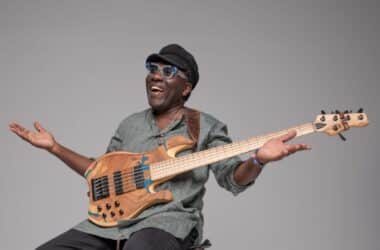It always seems to start the same way.
I’ll beat you up!
A brush-fire confrontation between strangers in a subway loudly skyrockets toward hostility before anyone else is even sure who is yelling at whom, or why.
C’mon man! Do something about it!
A moment so familiar that other passengers hardly bother to look up from their phones or pause their conversations.
I’m gonna beat you up — only you. Just you.
But a fight on Thursday on a speeding A train in Brooklyn that started with those taunts did not end there. It continued to escalate before a rush-hour crowd, from words to fists to a blade to, finally, a gun.
The encounter came just over a week after New York’s governor took the extraordinary step of ordering the National Guard below ground to make the trains feel safer. The shooting undermined the city’s message that riding the subway is, statistically speaking, quite safe.
The episode fueled a sense of futility about a system that seems to catch all the troubles from the city above — mental health crises, illegal guns — and squeezes them into crowded steel tubes.
For those on that A train on Thursday, some with small children by their side, no city statistic is likely to bring comfort. Send the police, send in the Guard — many have come to believe that, regardless, the subway is going to be the subway.
Videos of fights or shootings are everywhere, and they come and they go. This one, with its familiar rhythms, stands out.
The shooting on Thursday is not just a crazy thing that happened on an A train one day.
It seems more like a clear display of the state of the city above, a sense of metropolitan anxiety that has been felt, described and debated from Flatbush to Fordham and back again. A broken little piece of a place that made its way below ground, for everyone to see.
0:01
The video begins after whatever kicked off the encounter. Something set one passenger off, a man in dark clothing and a ball cap. He relentlessly hurls taunt after taunt at a silent man who is sitting. Sometimes, he leans over the man, shouting.
The train drives on without pause along an express track with extended gaps between stations. No one seems to care about a level of hostility that would never be allowed to escalate on other forms of transportation — on an airplane, for example, a setting just as cramped and prone to frustrated passengers. On a subway, threatening shouting might simply be called: Thursday.
The woman recording the video makes this very point in her own way, pausing to point the camera at her own blank face, unimpressed: Here we go again.
Finally, the seated man, seemingly done taking abuse, rises and crouches into a fighting stance. The shouting man seems delighted with the challenge, squaring up. It is only then that a dozen or more nearby passengers collectively decide that it is time to back away, pushing toward the opposite end of the car.
‘Little stuff that shouldn’t matter’
Aroldo Gonzalez, 20, knows too well of that moment. The panic, louder than the questions — why? What’s going on? — and the need to get away.
In April 2022, Mr. Gonzalez was riding an N train in Brooklyn when a man rose from his seat and opened fire. That man, Frank James, shot and wounded Mr. Gonzalez and nine other people, and was convicted and given 10 life sentences.
Mr. Gonzalez rides the trains now with a heightened awareness, bristling at the start of any argument.
“I definitely do give them more thought now,” he said Saturday of the altercations. “I don’t know what someone is capable of. It doesn’t even have to be an argument. It just has to be someone being louder than someone should be.”
He remains mystified, as do many, about why a bump or a misunderstanding seemingly has to rise to shouting.
“Just, like, little stuff that shouldn’t matter,” he said. “Simple things that could be fixed with a ‘sorry’ or ‘excuse me.’”
1:24
On the A train Thursday, the two men — far past “excuse me” — circled one another around a pole before throwing a few sloppy punches and tumbling onto an empty bench. But then a young woman, perhaps a companion of the man who had been taunted, darted out of the crowd and seemed to cut the yelling man in the back with a blade.
“You stabbed me?” he asked her with genuine surprise. He reached around to his back, to feel beneath a growing red spot on his shirt.
A bystander wearing a safety vest stepped in. He calmly separated the men, who seemed to comply. The fight might have ended there.
Then the bleeding man rose and shrugged off his jacket and tossed it to another bench. It landed not softly, but with a heavy thud.
No one heard. Many passengers had been shouting during the brief fistfight — “There are babies on here!” — and no one paid any mind to what might have been in the jacket.
The bleeding man seemed to decide on his next move. “I’m locking you up!” he shouted. Then he reached down and pulled from the jacket’s pocket a gun.
Moments later, four shots echoed through the train and Hoyt-Schermerhorn station.
Data, fear and resignation
Officials fall back on numbers that suggest finding oneself the victim of a crime on a subway is statistically unlikely. The number of assaults on a given day is tiny compared with the number of riders and rides. This resonates for many: A recent survey by the Metropolitan Transportation Authority found that a little more than half of riders felt the subway was safe.
And yet, another video from Thursday has surfaced. It was taken in a nearby car on the same A train.
Dozens of riders — too many to count on the screen — have dropped to the floor. Some cry. Others peek around and then drop their heads again. Someone shouts for help. There is no immediate response.
It is an image that feels more of the moment than any number.
“I don’t want to be in New York,” the woman who took the video, Sherri Paul, told FOX News the next day. “I don’t see myself in New York if I have to ride the train, taking the bus. I don’t think it’s safe for me.”
The fear she described was familiar to Mr. Gonzalez, who recently acknowledged it’s been one year and 11 months since he was shot by Mr. James on the train, the bullet piercing his calf and lodging under his knee. He couldn’t face the subways for a time.
But now, that fear has calcified into resignation.
“They said they’d have more people patrolling,” he said, thinking back to 2022. “I think it’s been the same if not worse. I see people doing stuff, homeless people acting out. A bunch of stuff that was supposedly going to get fixed but hasn’t at all.”
4:11
The A train doors had finally opened at Hoyt-Schermerhorn station, which pushes passengers in and out of Brooklyn along busy lines. The police swarmed the station and closed it down to investigate what had happened.
The bleeding man was last seen on the video holding a gun and walking toward the other man. But seconds later, it was he who was shot, in the head, after the other man apparently grabbed his gun, the police said. He was hospitalized in critical but stable condition.
While these facts slowly emerged, crowded trains stalled in both directions, with passengers given no clue to what was causing the delay.
On a different A train nearby, the afternoon commute stopped at the High Street station, and stayed there. Five minutes became 10, and then 20. No explanations were forthcoming beyond “police activity.” Frustration mounted.
It always seems to start the same way.
“You’re sitting there, and I’m old enough to be your mother!” a woman could be heard shouting. Whomever she was shouting at said something, and the woman yelled even louder.
Some laughed. Most just sat there. The shouting continued, until whoever it was getting yelled at rose and left the car.
Just another Thursday.





